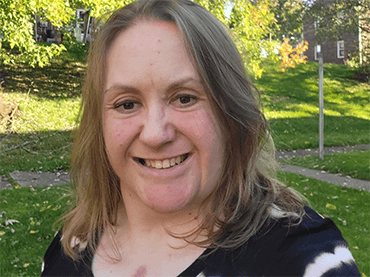Ann Sisley is thankful to be alive. In 2013, she had emergency surgery to repair a ruptured aortic aneurysm. Eight years later, she had emergency surgery for an aortic dissection. Each time, her life was saved in open heart procedures performed by experts at the UPMC Center for Aortic Disease — part of the UPMC Heart and Vascular Institute.
The Problem: Thoracic Aortic Disease Linked to Turner Syndrome
Ann was born with Turner Syndrome — a genetic chromosomal disorder affecting only females. Women who are born with TS are predisposed to various health issues, including heart problems that may develop over time.
Because of that, Ann made sure she saw her primary care doctor for regular checkups when she became an adult. Routine echocardiograms showed Ann had a bicuspid aortic valve with two flaps instead of three, which required monitoring. All was well until 2013 when she went for a routine physical. That’s when her doctor detected an unusual heart murmur in the 29-year-old’s coronary arteries.
The Path to UPMC Heart and Vascular Institute
That worrisome sound prompted a cardiac workup and a referral to the UPMC Center for Aortic Disease, part of the UPMC Heart and Vascular Institute. Additional testing revealed an aortic aneurysm and a Kommerell diverticulum — a very rare congenital defect of the aortic arch — with a misplaced subclavian artery.
The aneurysm needed to be repaired. But first, surgery was needed to reroute the subclavian artery to improve blood flow and prevent stroke. Surgery was being planned when Ann passed out during a church retreat. The aneurysm had ruptured.
“I felt off, like I couldn’t sit still. And I had hot flashes,” says Ann. “I passed out. When I woke up, I had chest pain.”
She was rushed to UPMC Shadyside, where surgeons first operated on her arteries, then repaired the ruptured aneurysm by replacing the descending aorta with a synthetic graft.
“It was a pretty serious situation. But I knew I was in good hands,” says Ann. “I trusted my doctor.”
Back to UPMC After Another Emergency
Ann recovered from surgery and returned to her job as a pediatric triage nurse at UPMC Children’s Community Pediatrics in Moon Township. She also resumed her activities, including walking three to four miles several times a week.
She continued to see the UPMC Center for Aortic Disease team for regular checkups. But in 2021 at age 37, Ann didn’t feel well.
“I felt this strange sharp sore throat. It was nothing I ever had before,” she says. “There was also a heaviness in my chest and upper arms.”
Eight years after her first emergency surgery, Ann was back at UPMC Shadyside with a life-threatening aortic dissection.
The Solution: Repair of the Dissected Aorta
An aortic dissection is a tear in the innermost layer of the aorta, which is the body’s main artery. Ann had a type A dissection — a dangerous tear in the ascending aorta, the section closest to the heart. It’s where blood exits the heart and goes to the rest of the body.
She was rushed into the operating room where surgeons replaced her aortic root, ascending aorta, and aortic arch, using a mechanical valve and a synthetic graft. Three days later, a permanent pacemaker was inserted to help regulate her heartbeat.
Five days after her surgery, Ann returned to her Baden, Pa., home. One of her biggest hurdles was getting used to her powerful heartbeat.
“I could hear it and I could feel it. I could take my pulse just by listening,” says Ann. “It was like a drumbeat.”
After some adjustments to her pacemaker and talking to her surgeons and therapists, Ann adapted to the heartbeat. She also began cardiac rehabilitation at UPMC Passavant-Cranberry.
“At first, I was afraid to lift things or move around a lot. But rehab made such a difference. It helped me become me more active,” says Ann.
“The therapy and the exercises helped build my strength and my confidence. It showed me what I was capable of so I could resume my activities.”
The Results: Living a Normal Life
Today, Ann says she’s feeling “very strong, very good.” She returned to her job as a full-time pediatric triage nurse and is active in her church. She also exercises regularly. At her gym, she swims and uses the treadmill, recumbent bike, light cardiac weights, and hand cycle. She also routinely walks one to two miles around her neighborhood or at a nearby park.
In addition to regular follow-up visits with her surgeons, she also sees Venmathi Indramohan, MD, who monitors the coumadin she takes to prevent stroke. Dr. Indramohan is a cardiologist at the Magee-Womens Heart Program at UPMC Passavant, part of the UPMC Heart and Vascular Institute.
“I would have died — twice — without the knowledge and expertise of my surgeon and the other experts at the UPMC Heart and Vascular Institute,” says Ann. “I’m living a normal life, thanks to the excellent care I received over the years. I’m in good hands.”

















